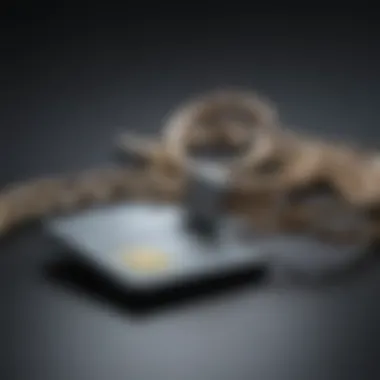Utilizing Jewelry Credit Cards to Enhance Your Credit Score


Intro
Using specific credit options for building credit has been an interesting strategy for many. One way involves taking advantage of jewelry credit cards, which can offer unique pathways for credit enhancement. These cards serve not only to make purchases but also help establish and improve a user's credit profile if managed responsibly.
This article seeks to disect the nuances of jewelry credit cards and how they fit into the larger scope of personal finance and credit management. We will discuss their functionalities, the benefits they provide and potential downsides. Additionally, best practices will be shared to maximize their effectiveness in the credit-scoring process. As you navigate this guide, expect a deeper understanding of how these credit tools impact one’s overall financial health.
Understanding Jewelry Credit Cards
Jewelry credit cards operate similarly to standard credit cards, yet they cater specifically to jewelry purchases. Frequently offered by jewelry retailers, these cards can assist consumers in managing a more significant financial commitment while acquiring jewelry.
Features of Jewelry Credit Cards
- Limited Usage: Generally, these cards are accepted exclusively at the issuing jeweler or their affiliated stores.
- Special Financing Offers: Many jewelry credit cards provide promotional terms like deferred interest during certain periods.
- Rewards Program: Some cards come with rewards linked to spending, specifically within their merchandise category.
Benefits of Using Jewelry Credit Cards
- Build Credit History: Regularly making on-time payments contributes positively to your credit score.
- Separate Financial Management: Keeping jewelry purchases on a specific card can help manage budgets intuitively.
- Exclusive Offers: Users might receive advantages like discounts, early access, or promotional events at specific retailers.
Drawbacks of Jewelry Credit Cards
- High Interest Rates: Many cards charge elevated rates after introductory offers, risking debt if not fully paid by a deadline.
- Limited Acceptance: Card restrictions can make these less versatile for everyday expenses.
- Potential Impact on Credit Utilization: High balances or missed payments can derail your credit score.
Understanding Jewelry Credit Cards
Understanding Jewelry Credit Cards is critical in the discussion of credit building. They are specialized credit accounts offered by jewelry retailers. For some individuals, these cards can serve as a pathway to improving their credit score. However, it is essential to grasp their unique characteristics, benefits, and pitfalls.
Jewelry credit cards focus on one specific area of spending; hence, they often come with terms that may differ from traditional credit cards. These specialized credit tools are meant for purchasing items typically deemed luxury or extravagant, creating an environment that may appeal specifically to high-value shoppers. Their perks can influence one’s credit history positively, providing opportunities that open doors or narrow them based on how one manages the associated accounts.
Driven by promotions and offer issuers often provide, making thoughtful purchasing decisions can add up over time and improve your ability to obtain other forms of credit. Moving with caution and understanding will help users harness jewelry credit cards effectively.
What are Jewelry Credit Cards?
Jewelry credit cards are credit lines catered specifically to buying jewelry. Many reputable retailers like Kay Jewelers and Zales offer these cards. Unlike general-purpose credit cards, they often feature loyalty rewards unique to the purchased products. For instance, members might gain discounts or exclusive deals on certain purchases.
Primarily, these cards target consumers who shop at specific locations, meaning their usability is generally limited. Because of this specialization, they may encourage users to make these suivent purchases, improving purchase frequency in a sector where consumer enjoyment may overshadow financial planning.
Importantly, these types of credit cards often report to credit bureaus, which assists cardholders in gradually elevating their credit scores when used responsibly. Having a product that can showcase particular bounding relationships fosters a balance of credit utilization and payment history.
How Jewelry Credit Cards Work
Jewelry credit cards operate similar to standard credit cards, allowing users to make purchases on credit. Upon approval, a credit limit is assigned. Customers can then use this available limit to shop for jewelry specific to the retailer's offerings.
When selecting to utilize a jewelry credit card, understanding the terms is essential. Most possess promotional periods featuring low or no interest rates for a time frame. It’s critical to note payment timing and terms to
The Role of Credit in Financial Health
Credit has become a part of daily life for many individuals. It plays a crucial role in determining financial freedom and flexibility. Having a healthy credit score can influence various aspects of life, from borrowing costs to employment opportunities. It serves as a reflection of one's creditworthiness, which can affect decisions made by lenders as well as landlords.
Importance of Building Credit
Building credit is not just about gaining access to loans. It is a vital aspect of securing economic stability. With good credit, borrowing money for significant purchases, like a car or a home, often comes with favorable terms and lower interest rates. Furthermore, good credit can lead to wider choices in financial products and services. Banks and credit unions are more inclined to offer favorable terms to those with high scores.


Sustaining a healthy credit profile can be of great benefit in different situations:
- Lower Insurance Rates: Insurers may consider credit scores while setting premium rates for auto or home insurance. Quality credit can lead to better rates.
- Rental Applications: Many landlords examine credit history when evaluating potential tenants. A lower score may restrict housing options or add to security deposit requirements.
- Employment Help: Certain employers check credit scores as part of their hiring process, especially for financially related positions.
Another key benefit of nurturing one’s credit is building trust with financial institutions. Responsible credit behavior illustrates a commitment to fiscal responsibility, often leading lenders to provide larger lines of credit in the future.
Factors That Influence Your Credit Score
Multiple elements combine to produce a credit score, encapsulating an individual's track record over time. The most notable factors include:
- Payment History: This is the largest component, accounting for roughly 35% of the score. Timeliness of payments speaks volumes about reliable offer consumers.
- Credit Utilization Ratio: Keeping balances low compared to credit limits is critical. A recommended ratio is 30% or lower, reflecting judicious spending habits.
- Length of Credit History: A longer credit history can positively impact your score, showing experience and consistency with credit management.
Incorporating these factors into one’s strategy for utilizing jewelry credit cards can lead to an improvement in the credit score. The calculation of credit scores can seem complex, making understanding these factors vital for anyone self-managing their finances.
To maximize the benefits of credit rebuilding, always prioritize timely payments and mindful spending habits.
Benefits of Using Jewelry Credit Cards for Credit Building
Utilizing jewelry credit cards can provide a compelling advantage for individuals eager to enhance their credit worthiness. These specialized credit cards focus on products perceived as luxury items, allowing holders to not only make fashionable purchases but also strategically improve their credit profiles.
When discussing the benefits of using jewelry credit cards for credit building, we must consider several points. First, these cards often evaluate individuals with less emphasis on their history with traditional credit facilities. Therefore, those with limited credit experience may find it easier to access these cards compared to other credit products.
Additionally, jewelry credit cards may help to cultivate responsible credit behaviors. Users have the chance to develop a better understanding of how to manage payment cycles, thus boosting their financial literacy.
Understanding Credit Utilization
Credit utilization refers to the ratio between total credit available and outstanding debt. It is a significant aspect of credit scoring. When one utilizes a jewelry credit card, they can positively impact this ratio. Utilizing a low percentage of the available credit is beneficial for credit scores. Having a specialized line like a jewelry credit card can aid in lowering the overall utilization if handled properly. Consider the following:
- Use only a fraction of the credit limit available.
- Pair purchases with the desire or need for jewelry; this assures that you only get what fits within budget.
- Consistently pay the balance to avoid high utilization in future months.
Important Note: Keeping your utilization below 30% of available credit is often recommended.”
Potential for Increased Credit Limits
Increasing credit limits can directly benefit your credit score. Jewelry credit cards can be unique in providing this potential expansion. Many jewelers aim to build lasting relationships with their clients, leading to supportive measures such as bumping up credit limits after positive payment behaviors. Having a higher credit limit can push utilization rate lower, even if spending remains the same. As you handle credit cards well:
- The issuer might offer periodic reviews for higher limits,
- A history of timely payments can also lend to a better chance of approvals.
Establishing Positive Payment History
Payment history contributes to a significant portion of credit scores. Consistent and on-time payments on a jewelry credit card can enhance credit profiles steadily. The goal here should not just be to make luxury purchases but to form a pattern of dependable behavior with creditors.
To optimize this venture:
- Always pay at least the minimum on time.
- Consider autopay features for continuous compliance,
- Monitor monthly statements closely to ensure consistent accuracy.
Defining a clear schedule for payments will go a long way in cementing that history. Furthermore, the perceived prestige associated with jewelry credit may motivate some to treat these obligations with higher priority than ordinary purchases.
Drawbacks and Risks Involved
Understanding the drawbacks and risks associated with jewelry credit cards is essential when considering them for building your credit score. While they offer unique benefits, the potential negative implications can significantly impact your financial health. This section highlights the challenges and considerations to help navigate these pitfalls appropriately.
High-Interest Rates and Fees


Many jewelry credit cards come with elevated interest rates. These rates can range considerably, often exceeding those of traditional credit cards. High-interest rates make it critical for you to manage any balances effectively. If left unpaid, interest accumulates, creating a hefty financial burden.
In addition to interest, certain fees may be linked with jewelry credit cards.
- Annual fees: Some cards charge yearly fees regardless of your usage level.
- Late payment fees: Failure to make timely payments incurs additional costs.
- Additional purchase fees: Financing large jewelry purchases can also incur extra jargon costs.
An understanding of these financial obligations can prevent unexpected financial strain. This situation becomes notably urgent if you make purchases absentmindedly, as the cost of indulgence could inflate past your initial expectations.
Impact of Mismanagement on Credit Score
Mismanagement of jewelry credit cards can adversely affect your credit score. Late payments sent credit reports into a serious decline. Your credit utilization ratio may also be affected. This ratio identifies how much of your available credit is being used. High utilization could suggest financial irresponsibility to creditors.
A missed payment not only harms your current score but also can have a lasting impact. Errors in dealing with credit limits or frequent exceeding can impact future loan applications.
A few points to consider:
- The importance of keeping utilization below 30%.
- Payments should be made promptly, ideally in full, to prevent interest accrual.
- Multiple missed or late payments seriously damage credit cards.
A vigilant approach to account management mitigates significant risks, ensuring consistent monitoring will guard your credit profile.
In summary, being cautious with jewelry credit cards is imperative. A well-calculated and informed approach ensures that the allure of immediate benefits does not overshadow potential drawbacks.
Best Practices for Using Jewelry Credit Cards
Using jewelry credit cards can be a practical way to build and enhance your credit score. Yet, it is crucial to employ specific best practices to ensure that you utilize these financial tools effectively. Adopting sound strategies not only safeguards against potential pitfalls but also maximizes the benefits of credit-building.
Setting a Budget for Purchases
Establishing a sensible budget before making any purchases with a jewelry credit card is essential. This involves assessing your financial situation and determining how much you can afford to spend without straining your budget. By setting a limit, you mitigate the risk of overspending, which can lead to acquiring debt that may be challenging to pay off later.
In addition to maintaining a budget, consider giving thought to the purpose of your purchase. Are you buying something genuinely desired, or is it merely an impulse buy? This assessment can guide you towards making more intentional purchases, which will contribute to a stronger positive payment history—a crucial factor in credit scores. Keep in mind that controlling spending correlates closely with managing overall financial health.
Timely Payments to Avoid Interest
One of the most significant advantages of jewelry credit cards is the capacity to build a positive credit history when you make timely payments. Late payments can result in high interest charges and penalties while also negatively impacting your credit score. To avoid these pitfalls, set reminders for payment due dates or align them with other bills. This approach helps to reinforce consistent and timely payments.
Paying off the balance in full each month not only minimizes interest but also positively reflects on your utilization ratio. A low utilization ratio can be beneficial since it signals to lenders that you are managing your credit responsibly. This forms an essential part of improving credit scores over time.
Monitoring Your Credit Score Regularly
Frequent monitoring of your credit score is a smart practice that supports ongoing credit management. Understanding how your financial behavior affects your score allows you to strategize better practices for credit card use. You can access your credit report once a year for free through various platforms, which is a step towards understanding your financial health. This practice allows you to spot errors that may negatively impact your score, which can be corrected promptly.
Additionally, monitoring credit scores can help track progress over time as you utilize your jewelry credit card. If you observe fluctuations in your credit score, analyze the causes, whether they relate to spending levels or payment behavior. This practice also allows you to gauge the effects of your spending decisions and payment patterns effectively.
Focus on consistent habits when using jewelry credit cards. Create a sustainable approach by adopting budgeting and payment strategies that align with your financial goals.
Implementing these practices while using jewelry credit cards can not only foster improved credit scores but also instill long-term financial discipline.
Jewelry Credit Cards vs.
Traditional Credit Cards
Understanding the contrast between jewelry credit cards and traditional credit cards is pertinint for borrowers that seek to enhance their credit profile. While both type of cards serve the underlying function of extending credit, they differ in significant ways that may impact the user's financial strategy. This section aims to highlight these differences clearly, shedding light on both benefits and considerations.


Differences in Terms and Conditions
Jewelry credit cards exebit distinct terms when it comes to interest rates, credit limits, and fees. Most jewelry store credit cards often have a higher interest rates than standard credit cards. But, they might grant a more lenient approval process for consumers, especially those with limited credit history.
- Interest Rates: Generally, jewelry credit cards can have APR as high as 28% or more, unfavorable compared to some traditional cards. Low interest options may exist but they are less common.
- Credit Limits: The credit limits on jewelry credit cards frequently start low compared to traditional options. This can initially limit purchasing power, but with on-time payments, some firms may increase your limit significantly.
- Fees: Many jewelry-specific cards have unique fees for late payments or efficient requested line increases. Traditional cards might also levy fees; however, they usually offer a wider variety of fee structures, allowing for more transparency.
Key Point: Users must carefully evaluate the specific terms related to these cards as each issuer can have its unique aspects that may benefit or disadvantage one's credit-building goals.
Usage Restrictions and Flexibility
Navigating the flexibility of jewelry credit cards contrasted with that of traditional ones reinforces important distinctions. Typically, jewelry credit cards appear constricted in applicability.
- Purchase Categories: These cards are frequently prescuribed solely to jewelry stores. Non-compatible establishments may deem the card inadaquate for purchases. Traditional credit cards, however, are widely accepted almost anywhere, from grocery stores to travel services.
- Rewards Programs: While traditional credit cards may offer versatile rewards interested in a variety of benefits, such as cashback or points redeemable for everything from travel to gas, jewelry credit cards can be limiting. Rewards often prioritize jewelry purchases,
- Repayment Flexibility: Some traditional cards allow you to negotiate terms or work with the lender in payment difficulties. Jewelry-specific cards may lack this flexibility.
Understanding these divergent elements isessentail for selecttting the right card to fortify financial structures. Creating an efficient credit strategy can prosper if one chooses the correct tools to structure the finances adequately.
Integrating Jewelry Credit Cards into Broader Credit Strategies
Integrating jewelry credit cards into a broader credit strategy offers significant opportunities likened to a gateway. This practice is not just about the physical items purchased but overlays a foundational seriousness in credit management. It is more than merely swiping a card; it requires an understanding of multifaceted credit use, careful planning, and tactical execution tailored to personal financial goals.
Having multiple credit accounts is one vital aspect of effective credit management. Each account can contribute positively to an individual's credit score if maintained properly. When considering jewelry credit cards, buyers often fail to recognize their specific place within an array of credit options. However, by identifying the benefits and the nuances of these accounts, an individual can foster a more robust credit profile.
Utilizing Multiple Credit Accounts Wisely
Multiple credit accounts benefit credit scores because they collectively build positive payment history while reducing overall utilization. A jewelry credit card provides not only access to unique retailers but can also add to the diversification of one’s credit portfolio. When a consumer manages these cards well, making timely payments and keeping balances low, the credit score can reflect the cumulative contributions.
Potential benefits include:
- Enhanced credit scoring categories, such as credit mixture.
- Providing increased access to different types of establishes lines of credit.
- Highlighting a commitment to payments over time.
Nevertheless, caution must temper the enthusiasm for multiple accounts. Each card carries inherent risks regarding overspending or accumulating debt. Hence, setting strict budgets for total expenditures across all cards can curb negative effects. Martialing the financial habits to strategize how jewelry credit cards appreach ensures an individual’s credit balance does not overburden a particular sector.
Combining with Other Financial Tools
Moreover, amalgamating jewelry credit cards with various finacial tools amplifies their effectiveness in a broader credit strategy. This cooperation can ideally include personal loans, installment plans from other retailers, and even balance transfer credit cards. Relationships between different financial products create waves in how credit reports begin to charge.
For instance, someone borrowing against a jewelry credit card to make larger purchases can capitalize on their selling weight whilst keeping access to favorable purchase power. Such synergy between a variety of credit enables consumers to optimize their financial footprint.
Furthermore, being educated about the terms regarding evaluations and rates from lending institutions grants an additional layer of complexity.利用する[/combine ''financial options effectively aids, decreasing obstacles in responses during repayments positively aligned with timely reliability.
To conclude, integrating jewelry credit cards within hybrid sustenanft structures shouldn’t be entirely viewed detachedly of supplementary credit availability. Every line of credit holds potential when leveraged strategically. Thus, achieving positive credit movements needs fueling activity through continuity in monitoring all metrics involved in credit agreements balancing symmetrically after being clarified as key financial ambitions.
Finale
The discussion around jewelry credit cards as a tool for building credit carries significant weight within the broader context of financial health. Understanding the nuances involved can not only aid individuals in enhancing their credit profile, but also promote clearer financial habits. Jewelry credit cards serve a dual purpose: they provide access to purchases that may hold sentimental value, while also contributing positively to an individual's credit score if used responsibly.
Summarizing Key Takeaways
- Understanding Jewelry Credit Cards: These specialized credit cards are designed specifically for jewelry purchases, allowing users to make significant acquisitions while building credit.
- Credit Utilization: Maintaining a low utilization ratio remains key. Utilization percentage can significantly affect one’s credit score, thus careful spending is advisable.
- Payment History Importance: Establishing a reliable payment history builds creditworthiness, reinforcing the need for diligent payment schedules.
- Interest Rates Awareness: With many jewelry credit cards, interest rates can be considerably higher compared to traditional credit cards. Once again, management of payments is crucial.
- Integration Into Broader Strategies: These cards should be seen not as standalone products but as pieces of a greater financial strategy, often blending well with diverse credit lines and financial tools.
Final Thoughts on Credit Building
A thoughtful approach to credit building extends far beyond the avenues of products available. Jewelry credit cards symbolize just one way through which individuals can blend desirability of purchases with long-term financial growth. The power to improve one's credit score gravitates around judicious use, strategic payments, and constant monitoring of accounts.
As one aims to improve financial health, embracing all tools available while remaining cautious of the associated risks remains essential.
"Credit management, no matter the tool used, is about responsibility and foresight."
This journey necessitates a balanced commitment and leaves many empowered in their quest for a solid financial future.







